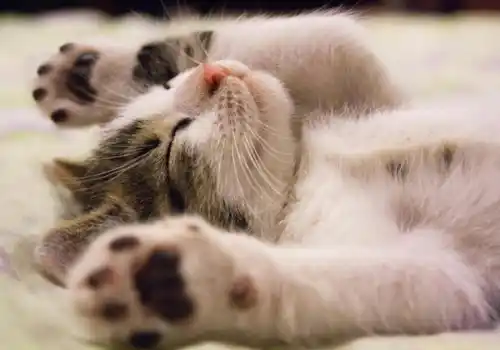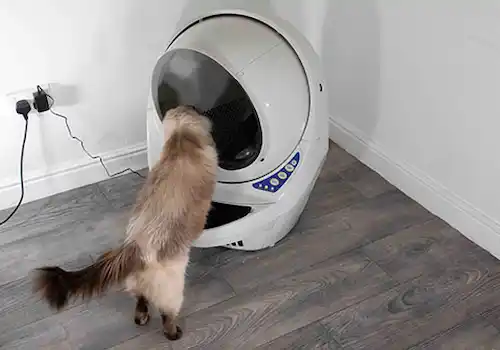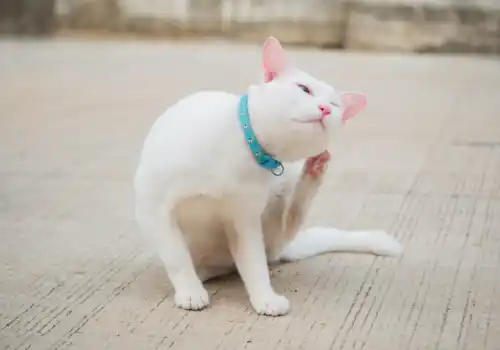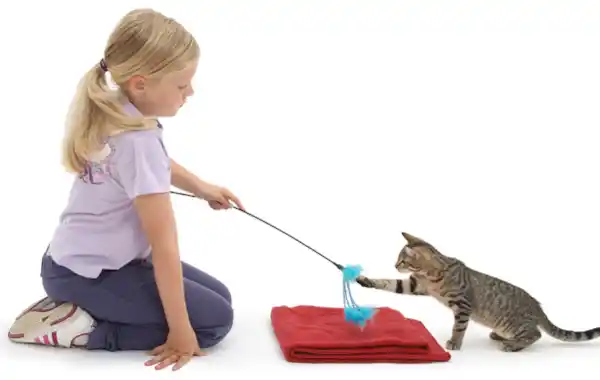Sarah and Chirag explain the tools you'll need to teach your cat in the third part of our series on training your cat.
Looking ahead to the next training feature (part 4), we will be providing the guidelines to the first cat training exercise on accepting a cat carrier. These exercises will not only help enhance your relationship with your feline friend but make essential handling for treatments and vet visits much easier for the both of you. However, before we start this we need to complete your knowledge on the tools you will need.
You get what you pay for
If you want your cat to do more of a certain behaviour, such as come towards you when you call him, you need to 'pay' this behaviour. This is because the first rule of animal training is that if you reinforce an action, you are likely to get more of it.
A reinforcer is anything your cat values enough at that moment to repeat the action he has just done to earn more of that reinforcement. This could be receiving a food treat, rubbing against you, opportunity to play with you or anything else that he wishes to do at that moment in time.
In the last training article, we looked at some of things that can be used as reinforcers but let's recap here about what you could use to reinforce your cat's behaviour:
Food
Every cat needs to eat, so if you start to substitute mealtimes with training sessions your cat can work for his daily food ration. If you feed wet food to your cat then feeding him via a spoon makes it easier to use as a reinforcer. Think about any extra goodies you feed your cat, such as treats, as these could also be used as reinforcers instead.
Some people think it's cruel to encourage their cat to work for food but research suggests that feral cats may eat 10 to 20 small meals during the day and night, most of which they would have to work for. Therefore, encouraging your cat to work for at least some of their daily food, whether it be some of the food usually used for meals or their treats, is actually a great way to prevent boredom and create mental and physical stimulation for your cat. Many of us use puzzle feeders for these exact reasons and training can be considered a similar tool.
It is really important that you do not starve your cat before training him, instead do your training before mealtimes or hold back on any treats for training sessions.
Play
Many cats enjoy playing, especially play that involves behaviours often used in hunting such as stalking, chasing and pouncing. You may have certain games your cat enjoys playing with you and you can use these as reinforcers during training too.
It is really important that you do not use your hands and feet as play items as often cats will use both biting and scratching behaviours during play. Such behaviours are a perfectly normal part of the play sequence but they should not be encouraged to be directed to body parts.
Praise and affection
Think of English as a second language to cats - it is not understood by them unless we have taught them that certain words have meaning. So often just saying 'good boy' will not mean very much unless it is followed by something they do understand, like a food treat or a stroke.
You may remember that in our first article, we talked about classical conditioning where one thing predicts another. Here, 'good boy' is consistently said before a treat or another form of reinforcer. The words 'good boy' in themselves will therefore become reinforcing as they predict that a treat is on its way.
Some cats really enjoy being groomed and petted, but remember this may only be at certain times and in certain ways. By watching your cat, you will start to notice whether speaking to or touching your cat appears to be enjoyable to him or not and in which situations. Research has shown that as a general rule, cats prefer to be petted on the head area (in particular the cheeks and chin) rather than other parts of the body.

Top tips to remember about reinforcers
Your cat decides what is reinforcing - reinforcers can have different values to cats in different situations. For example, food may not be that rewarding during an intense pounce-and-chase play session as cats normally wouldn't stop to eat in the middle of a hunt!
A variety of reinforcers can help create solid learning - if a particular reinforcer arouses your cat too much, it is probably too high in value for that situation so you may want to try something else. Key signs to identify high arousal include dilated pupils, swishing tail, repeated vocalisations and overly affectionate behaviour towards you - lots of facial rubbing against your hands which is known sometimes to end in a 'love bite' or 'love swipe' as opposed to a bite or scratch from a fearful or anxious cat
Likewise, if you use something as a reward that your cat has no interest in, then it is probably too low in value in that situation and not really perceived by your cat as a reinforcer
Be creative in how you deliver the reinforcer to your cat. It is often best not to hand-feed your cat during training but place the food rewards on the ground or in a bowl near to you. Cats have quite poor short range vision and so placing the treat right under the cat's nose may make it hard for the cat to see the treat. Since their vision is geared up to movement, rolling the treat on the floor can encourage the cat to accurately locate it
A reinforcer should encourage your cat to offer more of the behaviour you are reinforcing; if it doesn't then what you are using probably isn't a reinforcer in that context.
Reinforcers strengthen behaviour, so if there are things that your cat is already doing, you can reinforce them and he will be more likely to do them again in the future.
Capturing
This is where you simply catch your cat in the act of the desired behaviour and reinforce the action with him at that time. You may manipulate the environment to make it more likely that he engages in the behaviour you are waiting for (for example, if you want to capture and reinforce your cat for walking onto a particular mat or blanket then you could ensure this stands out for your cat by placing it in an area which is not cluttered and where distractions are minimal) but you just wait and reward when you see the desired behaviour.
However, often the things we want our cats to learn are things that they do not necessarily offer of their own accord - for example, entering the cat carrier or sitting still to be groomed. To help encourage new behaviours, trainers use the following tools:
Luring
You can use a lure such as a toy or treat to guide your cat into doing what you are trying to teach him, before you reinforce. For example, you may move a fishing rod-style toy to a mat to encourage him to move towards the mat, then when he gets to the mat, allow him to play with the wand toy.
After a few times of successfully luring the cat with the wand toy to the mat you can start to fade the use of the lure, by just showing the wand toy at the mat and waiting for him to move to the mat before you reinforce him. Soon, he will move to the mat whenever you place it down (without the need to use a toy as a lure) as it predicts something positive will occur at the mat.
Remember to provide the reinforcing thing immediately after the cat has reached the mat to ensure the positive association of mat and reward is strong.
If you use food to lure your cat instead of a toy, we suggest you place it on a spoon so that your hands are not at risk of an accidental swipe or bite as the cat follows the food.
Shaping
Using a combination of capturing and luring will help you teach your cat most things. However, often the cat will not offer the entire behaviour you want in one go, just a part of it.
For example, you may wish your cat to come when he is called so that you can call him in from the garden. Initially he may only come so far towards you but not the entire way. In this situation, you can do something called 'shaping' the behaviour. This means you accept and reinforce a behaviour which resembles a part of your final desired behaviour and only reinforce behaviour that is heading in the direction of what you want it to eventually look like.
Think about the game in which something is hidden and you shout 'hotter' or 'colder' depending on how close the person is to the prize. We are giving the person intermediate rewards by telling them they are close to the prize but not quite there yet. When the person gets even closer to the prize, we say 'even hotter'. This way we are 'shaping' their behaviour towards the location of the prize. This is the same principle we use in shaping our animals. So for the cat that comes a few steps towards you, reward this behaviour. The next time the cat comes a few steps closer, you reward this and no longer reward for the fewer steps. This way, we are encouraging the cat to come closer and closer to you and thus achieve the desired behaviour.
It is important you practise these tools with your cat ensuring you both understand them before moving onto the exercises starting in next month's issue.
Why would we want our cat to go to a mat?
There are lots of reasons - it is often the first stage of cat carrier training (more in the next article). You may also use a special mat to groom your cat on or take the mat to the vets for when he is examined. If the cat has learnt that the mat is a positive thing because it leads to rewards, taking that positive association with you to the vets may help him view the vet experience more positively.








